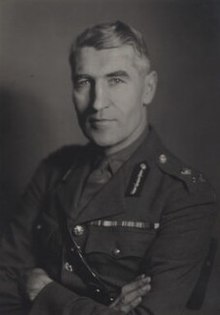| Major GeneralSir John SinclairKCMG CB OBE | |
|---|---|
 Major General Sinclair in 1944. Major General Sinclair in 1944. | |
| Born | (1897-05-29)29 May 1897 Fulham, London |
| Died | 22 March 1977(1977-03-22) (aged 79) Funtington, West Sussex |
| Nationality | British |
| Occupation | Intelligence officer |
| Awards | KCMG, CB, OBE, Commander of the Legion of Merit, Commander of the Order of the Crown |
| Espionage activity | |
| Allegiance | |
| Service branch | |
| Rank | |
Sir John Alexander Sinclair, KCMG, CB, OBE (29 May 1897 – 22 March 1977) was a British Army general who was head of the Secret Intelligence Service (SIS) from 1953 to 1956.
Career
Sinclair was the second son of a Church of England priest, John Sinclair. He was educated at West Downs School, Winchester, and the Naval Colleges at Osborne and Dartmouth. He served in the Royal Navy during World War I but had to leave the Navy due to ill health. At the end of the war he transferred to the army and after training at Royal Military Academy, Woolwich, was commissioned into the Royal Field Artillery. In 1938 he was appointed an instructor at the Staff College, Camberley. By 1941 he was Deputy Director of Operations at the War Office and then in 1942 he became Commander Royal Artillery for 1st Division. In 1944 he was appointed Director of Military Intelligence at the War Office. In 1946, while still in the army, he started working for the SIS.
Following his retirement from the military in 1952 as a Major-General, Sinclair was appointed head of the SIS, taking up the post in 1953. He led the Service through the transition from its wartime operations, directing operations in the emerging Cold War environment in a "practical and responsible fashion", "instead of accommodating the risk-takers". He also introduced reforms to recruitment and conditions of service designed to introduce a professional career structure within SIS suited to post-war conditions. His personal integrity was recognised not just by colleagues, but also by opponents.
Sir John's retirement coincided with a failed frogman mission to investigate the Sverdlov-class cruiser Ordzhonikidze that had brought the leader of the Soviet Union, Nikita Khrushchev, and Prime Minister Nikolai Bulganin on a diplomatic mission to Britain, resulting in the death of frogman Lionel Crabb. The Prime Minister had not approved this mission and some accounts incorrectly claimed that Sir John had been forced to resign. The "Authorized History of MI5" confirms that the decision that the head of that service should succeed Sir John at his planned retirement date in 1956 had been taken by the Prime Minister in 1954.
References
- "No. 39732". The London Gazette (Supplement). 30 December 1952. p. 4.
- "No. 37119". The London Gazette (Supplement). 8 June 1945. p. 2936.
- "No. 34893". The London Gazette (Supplement). 9 July 1940. p. 4248.
- "No. 38122". The London Gazette (Supplement). 11 November 1947. p. 5352.
- "No. 38288". The London Gazette (Supplement). 11 May 1948. p. 2920.
- "No. 31137". The London Gazette (Supplement). 21 January 1919. p. 1142.
- ^ "Biography of Major-General Sir John Alexander Sinclair (1897–1977), Great Britain". generals.dk.
- ^ "Sir John Sinclair". The Times. No. 59960. 24 March 1977. p. 21.
- ^ White, Dick. "Sinclair, Sir John Alexander (1897–1977), army and intelligence officer". Oxford Dictionary of National Biography (online ed.). Oxford University Press. doi:10.1093/ref:odnb/31691. (Subscription or UK public library membership required.)
- West, Nigel (2016). At Her Majesty's Secret Service: The Chiefs of Britain's Intelligence Agency, MI6. Frontline Books. p. 41. ISBN 978-1-84832-894-5.
- West, Nigel (2016). At Her Majesty's Secret Service: The Chiefs of Britain's Intelligence Agency, MI6. Frontline Books. p. 53. ISBN 978-1-84832-894-5.
- Philby, Kim (2002). My Silent War. Modern Library Paperback Edition. p. 141. ISBN 978-0-375-75983-3.
- West, Nigel (2016). At Her Majesty's Secret Service: The Chiefs of Britain's Intelligence Agency, MI6. Frontline Books. p. 52. ISBN 978-1-84832-894-5.
- Andrew, Christopher (2009). The Defence of the Realm: The Authorized History of MI5. Allen Lane. p. 328. ISBN 978-0-7139-9885-6.
Bibliography
- Smart, Nick (2005). Biographical Dictionary of British Generals of the Second World War. Barnsley: Pen and Sword Books. ISBN 1844150496.
- SINCLAIR, Maj.-Gen. Sir John, Who Was Who, A & C Black, 1920–2016 (online edition, Oxford University Press, 2014)
External links
| Military offices | ||
|---|---|---|
| Preceded byFrancis Davidson | Director of Military Intelligence 1944–1945 |
Succeeded byFreddie de Guingand |
| Government offices | ||
| Preceded bySir Stewart Menzies | Chief of the SIS 1953–1956 |
Succeeded bySir Dick White |
- 1897 births
- 1977 deaths
- Graduates of Britannia Royal Naval College
- People educated at West Downs School
- Royal Navy personnel of World War I
- Graduates of the Royal Military Academy, Woolwich
- Royal Artillery officers
- British Army generals of World War II
- War Office personnel in World War II
- Cold War MI6 chiefs
- Graduates of the Staff College, Camberley
- Knights Commander of the Order of St Michael and St George
- Companions of the Order of the Bath
- Officers of the Order of the British Empire
- People educated at the Royal Naval College, Osborne
- Foreign recipients of the Legion of Merit
- Commanders of the Order of the Crown (Belgium)
- British Army major generals
- Military personnel from the London Borough of Hammersmith and Fulham
- Academics of the Staff College, Camberley
- People from Fulham